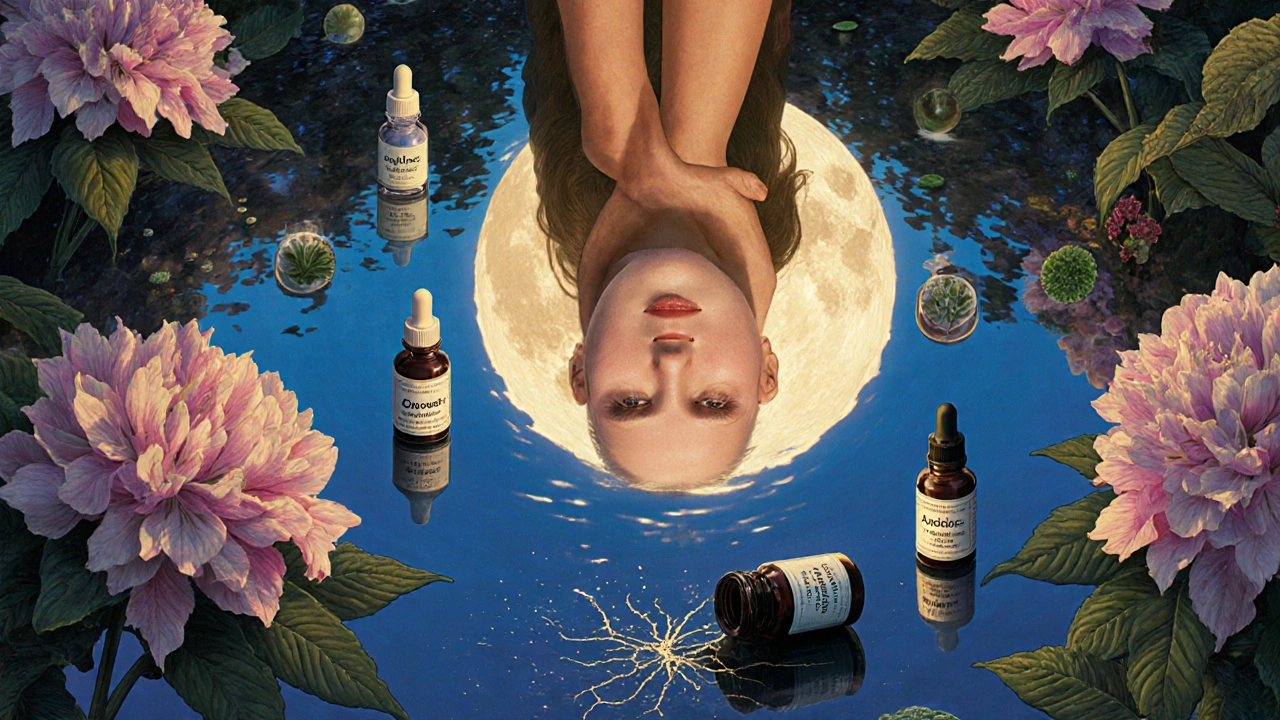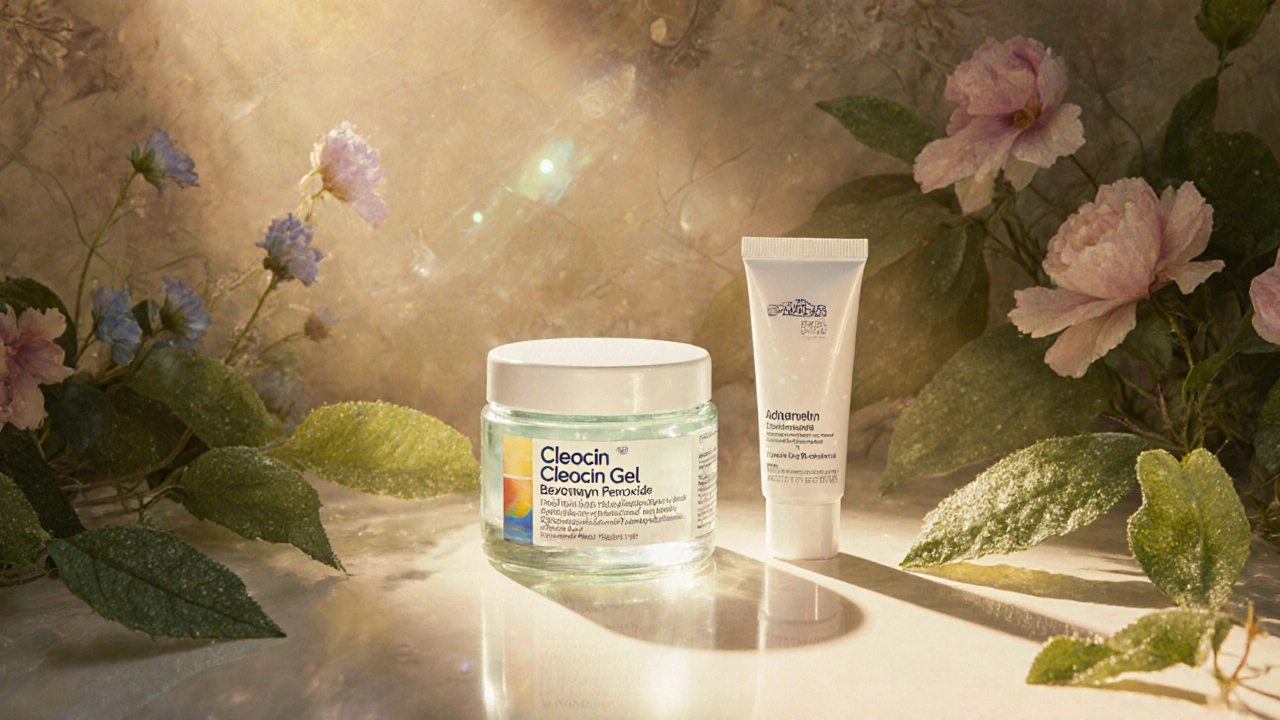Acne Treatment Finder
Discover which acne treatments work best for your specific skin type and concerns. Answer a few questions to get personalized recommendations from a dermatologist's perspective.
Cleocin Gel is one of the most commonly prescribed topical treatments for acne, especially for people with inflammatory breakouts like red bumps and pus-filled pimples. But is it the best option? And if it doesn’t work for you, what else can you try? Many people start with Cleocin Gel because their doctor recommends it, only to find it doesn’t clear their skin after a few weeks. That’s not unusual. The truth is, acne treatment isn’t one-size-fits-all. What works for your friend might do nothing for you. Let’s break down how Cleocin Gel stacks up against other treatments - both prescription and over-the-counter - so you know exactly what to ask your doctor or pharmacist next.
What Cleocin Gel Actually Does
Cleocin Gel is a topical antibiotic containing clindamycin phosphate, typically available in 1% concentration. It was approved by the FDA in the 1980s and has remained a staple in acne care ever since. Unlike oral antibiotics, it doesn’t circulate through your whole body. Instead, it sits right on your skin, targeting the bacteria that cause inflammation - mainly Propionibacterium acnes (now called Cutibacterium acnes).
Clindamycin works by stopping bacteria from making proteins they need to survive. It doesn’t kill all the bacteria, but it slows them down enough that your skin’s natural healing process can catch up. Most people start seeing fewer new pimples after 4 to 6 weeks. Full results usually take 8 to 12 weeks.
But here’s the catch: Cleocin Gel doesn’t touch the root causes of acne - excess oil, clogged pores, or hormonal triggers. It only handles the bacterial side. That’s why many people use it alongside other treatments like benzoyl peroxide or retinoids.
How Cleocin Gel Compares to Benzoyl Peroxide
If you’ve ever walked into a pharmacy looking for acne products, you’ve probably seen benzoyl peroxide on the shelf. It’s in everything - cleansers, spot treatments, lotions. And for good reason: it’s cheap, effective, and works differently than antibiotics.
Benzoyl peroxide is a topical agent that kills bacteria, reduces inflammation, and helps unclog pores by breaking down dead skin cells. It comes in strengths from 2.5% to 10%. Studies show that 5% benzoyl peroxide is just as effective as 1% clindamycin for reducing inflammatory acne lesions - but with one big advantage: it doesn’t lead to antibiotic resistance.
That’s critical. Overuse of antibiotics like clindamycin has led to strains of acne bacteria that no longer respond to it. The American Academy of Dermatology now recommends combining clindamycin with benzoyl peroxide to reduce this risk. In fact, many dermatologists now prescribe Clindamycin + Benzoyl Peroxide gels (like Benzaclin or Clindamycin-BPO) as a first-line treatment.
Downside? Benzoyl peroxide can dry out your skin, bleach towels and pillowcases, and cause redness or peeling - especially at higher concentrations. If your skin is sensitive, start with 2.5% and use it every other night.
Topical Retinoids: The Real Game-Changer
If you’ve tried Cleocin Gel and still get blackheads and clogged pores, you’re missing the biggest piece of the puzzle: pore unclogging. That’s where topical retinoids come in.
Adapalene (sold as Differin Gel) is a retinoid available over the counter in 0.1% strength. It’s not an antibiotic. Instead, it speeds up skin cell turnover, prevents pores from getting blocked, and reduces inflammation. It works on all types of acne - whiteheads, blackheads, and pimples.
A 2023 study in the Journal of Clinical and Aesthetic Dermatology found that patients using adapalene alone saw a 62% reduction in acne lesions after 12 weeks. When combined with clindamycin, the improvement jumped to 78%. That’s why many dermatologists now recommend starting with adapalene, then adding clindamycin only if inflammatory breakouts persist.
Retinoids can cause initial irritation - dryness, flaking, redness - especially in the first 2 to 4 weeks. But that usually settles down. Use a pea-sized amount, apply at night, and always use sunscreen the next day. Unlike Cleocin Gel, retinoids address the core issue: clogged pores.

Other Prescription Alternatives
There are other prescription topicals you might not know about - and they might be better suited to your skin type.
- Azelaic acid (Finacea, Skinoren): A gentle option that reduces redness, kills bacteria, and exfoliates. Great for rosacea-prone skin or sensitive skin that can’t tolerate retinoids or benzoyl peroxide. Works in 6 to 8 weeks.
- Topical dapsone (Aczone): An anti-inflammatory that’s especially effective for adult female acne. Doesn’t cause bacterial resistance. Often used for stubborn, red bumps around the jawline.
- Topical sulfur: An old-school remedy that’s making a comeback. It’s antimicrobial and helps dry out pimples. Often found in masks or spot treatments. Less irritating than benzoyl peroxide, but smells strong.
These alternatives are often prescribed when antibiotics stop working, or when patients want to avoid long-term antibiotic use. Dapsone, for example, is now preferred over clindamycin for adult women with hormonal acne - and it’s not associated with antibiotic resistance.
Over-the-Counter Options That Actually Work
You don’t always need a prescription. Many OTC products deliver real results.
- Salicylic acid (0.5%-2%): A beta-hydroxy acid that dissolves oil and clears pores. Best for blackheads and mild acne. Works well in cleansers or toners.
- Niacinamide (5%-10%): Reduces inflammation, regulates oil, and improves skin barrier function. Works well with other treatments and is gentle enough for daily use.
- Tea tree oil (5% dilution): A natural antimicrobial. A 2022 study in the Journal of Dermatological Treatment found 5% tea tree oil reduced acne lesions by 40% over 12 weeks - slightly less than benzoyl peroxide, but with fewer side effects.
These won’t replace prescription treatments for moderate to severe acne, but they’re excellent for maintenance or mild cases. Niacinamide, in particular, pairs well with Cleocin Gel - it calms irritation and boosts skin repair.

When Cleocin Gel Might Not Be Right for You
Here are four signs you should consider switching from Cleocin Gel:
- You’ve used it for 12 weeks and see no improvement.
- Your acne is mostly blackheads and clogged pores - not red bumps.
- You’ve had recurring breakouts after stopping the gel.
- Your skin is sensitive, red, or peeling from the gel.
Also, if you’ve used antibiotics before - whether for acne, sinus infections, or dental work - your skin bacteria may already be resistant to clindamycin. That’s why doctors now avoid prescribing it alone.
And if you’re pregnant or breastfeeding, avoid clindamycin unless your doctor says it’s safe. Azelaic acid and adapalene are preferred in pregnancy.
What Dermatologists Actually Recommend Today
Based on 2024 guidelines from the British Association of Dermatologists and the American Academy of Dermatology, here’s what works best in practice:
- Mild acne: Start with adapalene gel + niacinamide serum. Add benzoyl peroxide if needed.
- Moderate inflammatory acne: Combine adapalene with clindamycin-benzoyl peroxide gel (like Benzaclin). Use for 8-12 weeks, then taper off antibiotics.
- Adult female acne: Azelaic acid or dapsone as first-line. Hormonal therapy may be added if needed.
- After clearing acne: Keep using adapalene or niacinamide to prevent recurrence. Antibiotics are not for long-term use.
The trend is clear: antibiotics like Cleocin Gel are no longer the starting point. They’re a short-term tool - used with other treatments to reduce resistance and improve results.
Bottom Line: What Should You Do?
If you’re currently using Cleocin Gel and it’s working - great. But don’t use it alone. Pair it with benzoyl peroxide or adapalene. If it’s not working after 8 weeks, talk to your doctor about switching. Don’t keep using something that’s not helping just because it’s prescribed.
For most people, the best long-term strategy is a combination approach:
- Use a retinoid (like adapalene) every night to keep pores clear.
- Use benzoyl peroxide or azelaic acid in the morning to kill bacteria and reduce redness.
- Use Cleocin Gel only if you have persistent inflammatory breakouts - and never for more than 3 months.
Acne isn’t just about killing bacteria. It’s about keeping pores open, calming inflammation, and balancing your skin’s natural cycle. Cleocin Gel helps with one piece. The best results come when you combine it with the right tools for the rest.
Is Cleocin Gel better than benzoyl peroxide for acne?
Neither is universally better. Benzoyl peroxide kills bacteria and unclogs pores without causing resistance, while Cleocin Gel only targets bacteria. Studies show they work equally well for inflammatory acne - but combining them gives better results and prevents antibiotic resistance. Dermatologists now recommend using them together, not alone.
Can I use Cleocin Gel every day?
Yes, you can use Cleocin Gel once or twice daily as directed. But long-term daily use (over 3 months) increases the risk of antibiotic resistance. Most dermatologists recommend using it for 8-12 weeks, then switching to non-antibiotic treatments like adapalene or azelaic acid for maintenance.
Does Cleocin Gel work on blackheads?
No, Cleocin Gel doesn’t work well on blackheads. It targets bacteria that cause inflamed pimples, but it doesn’t unclog pores. For blackheads, you need ingredients like salicylic acid, adapalene, or benzoyl peroxide that exfoliate and clear out pores.
How long does it take for Cleocin Gel to work?
You may notice fewer new pimples after 4-6 weeks. Full improvement usually takes 8-12 weeks. If you don’t see results by 12 weeks, it’s likely not the right treatment for your type of acne. Talk to your doctor about alternatives.
Is Cleocin Gel safe during pregnancy?
Cleocin Gel is classified as Pregnancy Category B, meaning animal studies show no risk, but human data is limited. Many dermatologists avoid prescribing it during pregnancy and recommend azelaic acid or adapalene instead - both have more safety data for expectant mothers.
If you’re tired of trial and error with acne treatments, remember this: the goal isn’t just to kill bacteria. It’s to restore your skin’s natural balance. Cleocin Gel has its place - but it’s just one tool in a much bigger toolkit.

Susan Karabin
October 30, 2025 AT 08:22Been using adapalene for 6 months now and my skin hasn't looked this clear since high school
No more red bumps no more clogged pores just smooth skin
Clindamycin was a waste of time for me
I started with it like everyone else then switched and never looked back
Lorena Cabal Lopez
October 31, 2025 AT 19:06Wow someone finally said it
Antibiotics are overrated
Stuart Palley
November 1, 2025 AT 11:09THIS IS WHY YOUR SKIN IS STILL A MESS
You're still thinking like a 2005 dermatology textbook
Clindamycin is a bandaid for lazy people who don't want to deal with retinoids
It's not that it doesn't work it's that it's a crutch
And now your skin is dependent on it
Wake up people
Glenda Walsh
November 3, 2025 AT 03:01Wait wait wait-I just want to say I tried benzoyl peroxide and it burned my face so bad I cried-and I’m not even sensitive!!
Also my pillowcase turned white and I had to buy new ones and now I’m mad at the universe
And then I tried tea tree oil and it smelled like a forest fire and I couldn’t sleep
So I just use moisturizer now and pretend it’s fine
Tanuja Santhanakrishnan
November 4, 2025 AT 12:25As someone from India where acne is super common but dermatologists are hard to find-I’ve seen so many people struggle with this!
Here’s the thing: in my village, grandmas used turmeric and honey and it worked surprisingly well
But scientifically? Adapalene is the real MVP
Start with 0.1% every other night, pair it with niacinamide, and give it 8 weeks
Don’t rush it-skin healing is like growing a plant, not flipping a switch
And please, please, please use sunscreen
Your future self will thank you
Also-don’t forget to hydrate from inside out
Water, sleep, less sugar-it all connects!
Raj Modi
November 4, 2025 AT 16:54It is imperative to acknowledge the paradigmatic shift in contemporary dermatological practice regarding the therapeutic management of acne vulgaris
Whereas prior to the mid-2010s, topical antibiotics constituted the cornerstone of first-line intervention, current evidence-based guidelines, as promulgated by the American Academy of Dermatology and the British Association of Dermatologists, strongly advocate for a multi-modal, non-antibiotic-centric approach
Topical retinoids, particularly adapalene, demonstrate superior efficacy in addressing the fundamental pathophysiological mechanisms of comedogenesis and follicular hyperkeratinization
Furthermore, the emergence of antimicrobial resistance to clindamycin has rendered monotherapy not only suboptimal but potentially counterproductive
Therefore, the integration of benzoyl peroxide or azelaic acid with retinoids constitutes a synergistic regimen that not only enhances clinical outcomes but also mitigates the risk of microbial adaptation
It is, therefore, both clinically prudent and scientifically defensible to reframe acne treatment as a holistic, long-term dermal homeostasis strategy rather than a transient bactericidal intervention
Cecil Mays
November 5, 2025 AT 23:25Y’all need to try niacinamide 😍
It’s like a hug for your skin
My redness? Gone.
My oil? Controlled.
My confidence? Back.
And no burning. No peeling. Just calm.
Pair it with adapalene at night and you’re basically a glow-up wizard 🧙♀️✨
Stop fighting your skin. Start nurturing it.
Sarah Schmidt
November 7, 2025 AT 15:14People treat acne like it’s a moral failing-like if you just tried harder you’d be flawless
But the truth is your skin doesn’t care about your hustle
It cares about biology
And biology doesn’t care about your Instagram aesthetic
Clindamycin was never meant to be the hero
It was the sidekick
And now we’ve made it the protagonist
That’s not treatment
That’s delusion dressed up as a prescription
Billy Gambino
November 7, 2025 AT 23:01The systemic implications of topical antibiotic monotherapy in the context of cutaneous microbiome dysbiosis are not merely clinical-they are evolutionary
Clindamycin exerts selective pressure on Cutibacterium acnes strains, favoring the proliferation of resistant phenotypes with altered virulence factor expression
Meanwhile, retinoids modulate keratinocyte differentiation via RAR/RXR nuclear receptor pathways, thereby restoring follicular patency
Yet the medical-industrial complex continues to prioritize pharmacological convenience over physiological integrity
We are not treating acne
We are managing symptoms while the root pathology metastasizes
Karen Werling
November 8, 2025 AT 13:24I’m 37 and finally got my acne under control after 20 years of trying everything
Clindamycin? Did nothing for me
Adapalene? Took 3 months but now my skin is calm
My mom said I should’ve used rosehip oil
She was half right
But the real magic? Consistency
And not stressing about every little bump
My skin isn’t perfect
But it’s mine
And that’s enough 😊
STEVEN SHELLEY
November 9, 2025 AT 19:58THEY’RE HIDING THE TRUTH
CLINDAMYCIN IS A TRAP
THE PHARMA COMPANIES KNOW IT DOESN’T WORK LONG TERM
THEY KEEP SELLING IT BECAUSE IT MAKES THEM BILLIONS
AND DOCTORS ARE PAID TO PRESCRIBE IT
EVERYONE KNOWS RETINOIDS WORK BETTER
SO WHY AREN’T THEY PUSHING IT?
THEY WANT YOU DEPENDENT
THEY WANT YOU BUYING MORE GEL
THEY WANT YOU TO THINK YOU NEED ANTI-BIOTICS
IT’S A SCAM
OPEN YOUR EYES
Emil Tompkins
November 10, 2025 AT 10:00Okay but what if I told you… that acne is just your body trying to tell you you’re living wrong
Like maybe it’s not the gel
Maybe it’s your trauma
Maybe it’s your soy milk
Maybe it’s the moon phase
Maybe your pillowcase is haunted
Maybe you need to chant
Maybe you need to stop looking in the mirror
Maybe… maybe it’s not about the gel at all
Kevin Stone
November 12, 2025 AT 07:36I’ve been using Cleocin for 14 months now
It’s fine
It’s not perfect but it’s stable
And I don’t want to risk switching to something that might make it worse
Just because someone on the internet says it’s outdated doesn’t mean it’s wrong for me
My dermatologist says keep going
So I’m keeping going